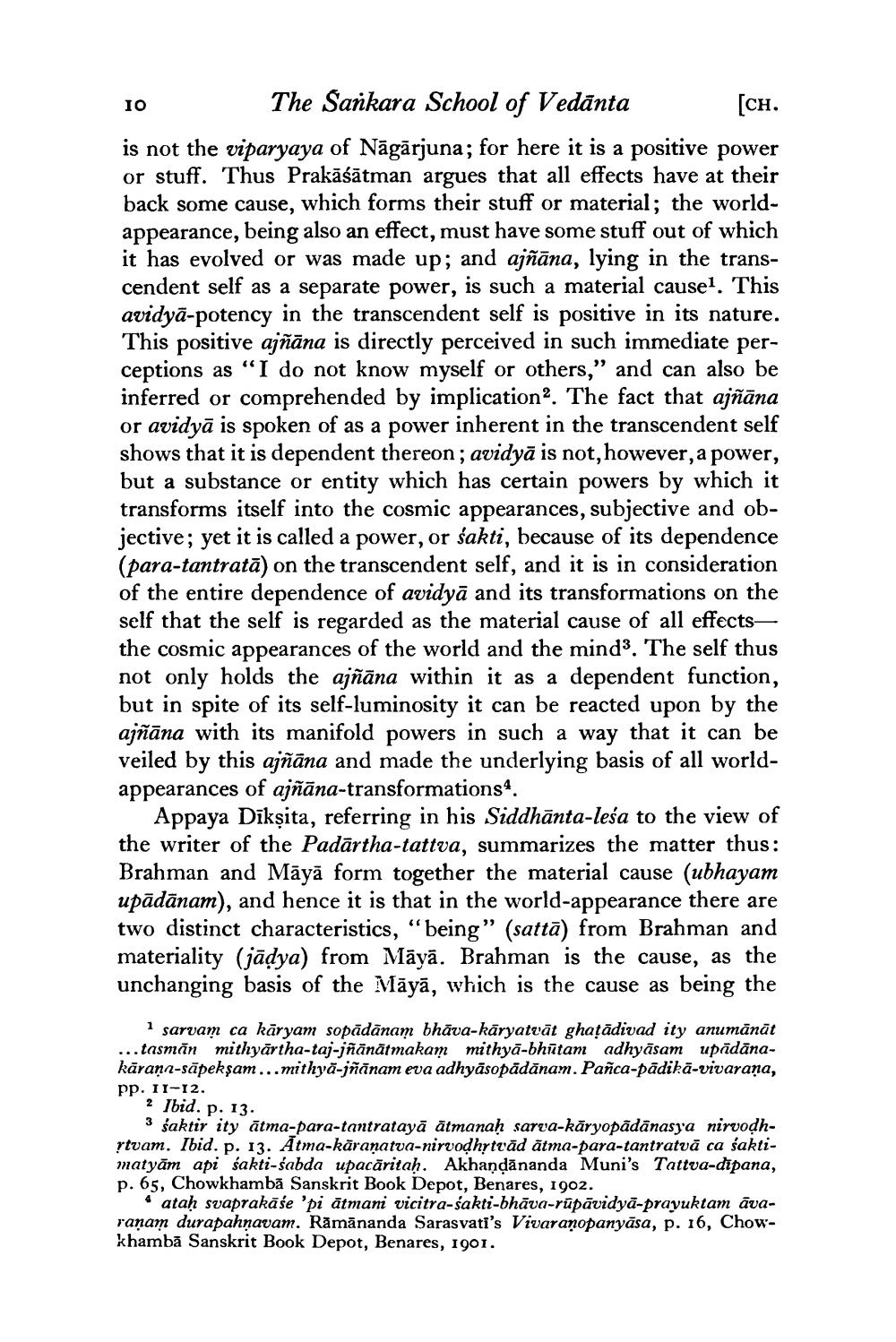________________
The Sankara School of Vedanta
[CH.
is not the viparyaya of Nāgārjuna; for here it is a positive power or stuff. Thus Prakāśātman argues that all effects have at their back some cause, which forms their stuff or material; the worldappearance, being also an effect, must have some stuff out of which it has evolved or was made up; and ajñāna, lying in the transcendent self as a separate power, is such a material cause1. This avidya-potency in the transcendent self is positive in its nature. This positive ajñāna is directly perceived in such immediate perceptions as "I do not know myself or others," and can also be inferred or comprehended by implication2. The fact that ajñāna or avidya is spoken of as a power inherent in the transcendent self shows that it is dependent thereon; avidyā is not, however, a power, but a substance or entity which has certain powers by which it transforms itself into the cosmic appearances, subjective and objective; yet it is called a power, or sakti, because of its dependence (para-tantrata) on the transcendent self, and it is in consideration of the entire dependence of avidyā and its transformations on the self that the self is regarded as the material cause of all effects— the cosmic appearances of the world and the mind3. The self thus not only holds the ajñāna within it as a dependent function, but in spite of its self-luminosity it can be reacted upon by the ajñāna with its manifold powers in such a way that it can be veiled by this ajñāna and made the underlying basis of all worldappearances of ajñāna-transformations1.
IO
Appaya Dikṣita, referring in his Siddhanta-lesa to the view of the writer of the Padartha-tattva, summarizes the matter thus: Brahman and Māyā form together the material cause (ubhayam upādānam), and hence it is that in the world-appearance there are two distinct characteristics, "being" (sattā) from Brahman and materiality (jāḍya) from Māyā. Brahman is the cause, as the unchanging basis of the Maya, which is the cause as being the
1 sarvam ca kāryam sopādānam bhāva-kāryatvāt ghaṭādivad ity anumānāt ...tasman mithyārtha-taj-jñānātmakam mithya-bhūtam adhyāsam upādānakāraṇa-sāpekşam...mithya-jñānam eva adhyāsopādānam. Pañca-pādikā-vivaraṇa,
pp. 11-12.
2 Ibid. p. 13.
3 śaktir ity atma-para-tantratayā ātmanaḥ sarva-kāryopādānasya nirvoḍhrtvam. Ibid. p. 13. Ātma-kāraṇatva-nirvoḍhṛtvād ātma-para-tantratvā ca śaktimatyām api śakti-sabda upacaritaḥ. Akhaṇḍānanda Muni's Tattva-dipana, p. 65, Chowkhamba Sanskrit Book Depot, Benares, 1902.
ataḥ svaprakāśe 'pi ātmani vicitra-sakti-bhāva-rūpāvidyā-prayuktam āvaraṇam durapahṇavam. Rāmānanda Sarasvati's Vivaraṇopanyasa, p. 16, Chowkhamba Sanskrit Book Depot, Benares, 1901.




